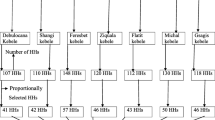Abstract
Purpose
Nigeria has the highest absolute number of residents who have undergone female genital mutilation (FGM) and most are carried out during infancy; however most reports on FGM are from urban based facilities hence we sought to know the perception and attitude of pregnant women residing in a rural community in northern Nigeria to FGM.
Methods
A descriptive cross sectional study utilized a pretested structured interviewer administered questionnaire to assess the types of FGM known, reasons for performing it and willingness to support or perform FGM among 323 pregnant women attending antenatal care in two different health facilities.
Results
Of the 323 respondents, 256 (79.3 %) were aware of the practice and the common varieties of FGM known to them were Gishiri cut in 137 (53.5 %) and Angurya cut 113 (44.1). The notable reasons for carrying out FGM in the community were tradition 88 (34.4 %), to ease difficulty in childbirth 69 (26.9 %) and better marriage prospect in 55 (21.5 %). Of the respondents that were aware of FGM; 100 (39.1 %) have experienced it and 55 (21.5 %) of those aware of it would subject their daughters to the procedure. There was statistically significant association between willingness to mutilate daughters by the respondents type of education (p = 0.014) and the type of facility they were receiving antenatal care (p = 0.001).
Conclusion
FGM is prevalent in this community with Gishiri cut being the commonest variety. It is often associated with difficult childbirth and many women would subject their daughters to this practice. Female education and empowerment is crucial to discontinuation of this practice.
Similar content being viewed by others
References
Department of Women’s Health, family and community health, World health Organization. A systematic review of the health complications of female genital mutilation including sequelae in childbirth. Geneva: World Health Organization, 2000 p 11
UNICEF Innocent Research Centre, “Changing a harmful social convention: female genital mutilation/cutting,” 2005. Accessed on 7th April 2014. Available at: http://www.unicef-irc.org/publications/pdf/fgm_eng.pdf
Johnsdotter S, Essen B (2010) Genitals and ethnicity: the politics of genital modifications. Reprod Health Matters 18(35):29–37
WHO Eliminating female genital mutilation an interagency statement - OHCHR, UNAIDS, UNDP, UNECA, UNESCO, UNFPA, UNHCR, UNICEF, UNIFEM, WHO. WHO, Geneva 2008
UNICEF Children’s and Women’s right in Nigeria: A wake up call. Situation Assessment and Analysis. Harmful traditional practice (FGM) Abuja NPC and UNICEF Nigeria 2001:195–200
National Population Commission and ICF Macro. 2009: National Demographic Health Survey 2008. Abuja, Nigeria chapter 18 p 299–314
Okeke TC, Anyaehie USB, Ezenyeaku CCK (2012) An overview of female genital mutilation in Nigeria. Ann Med Health Sci Res 2:70–73
Yola AI (2011) Yankan Gishiri (salt cut). Int J Obstet Trauma 1:2046–2065
Garba ID, Muhammad Z, Abubakar IS, Yakasai IA (2012) Prevalence of female genital mutilation among female infants in Kano Northern Nigeria. Arch Gynecol Obstet 86:423–428
Rushwan H (2000) Female genital mutilation management during pregnancy, childbirth and postpartum period. Int J Gynecol Obstet 70:99–104
Mandara MH (2004) Female genital mutilation in Nigeria. Int J Gynecol Obstet 84:291–298
Nkwo PO, Onah HE (2001) Decrease in female Genital mutilation among Nigeria Ibo girls. Int J Gynecol Obstet 75:321–322
Abubakar I, Iliyasu Z, Kabir M, Uzoho CC, Abdulkadir MB (2004) Knowledge attitude and practice of female genital cutting among antenatal patients in Aminu Kano Teaching Hospital Kano. Niger J Med 13(3):254–258
Jeremiah I, Kalio DGB, Akani C (2014) The pattern of female genital mutilation in port Harcourt southern Nigeria. Int J Trop Dis Health. 4(4):469–476
Ibekwe PC, Onoh RC, Onyebuchi AK, Ezeonu PO, Ibekwe RO (2012) Female Genital Mutilation in southeast Nigeria: a survey of current knowledge and practice. J Public Health Epid 4(5):117–122
Dattijo LM, Nyango AD, Osagie OE (2010) Awareness, perception and practice of female genital Mutilation among expectant mothers at Jos University Teaching Hospital, Jos North central Nigeria. Niger J Med 19(3):311–315
Ashimi AO, Aliyu LD, Shittu MA, Amole TG (2014) A multicentre study on knowledge and attitude of nurses in northern Nigeria concerning female genital mutilation. Eur J Obstet Gynaecol Contracept Reprod Health Care 19(2):134–140. doi:10.3109/13625187.2014.885940 Epub 2014 Mar 6
Ashimi AO, Omole-ohonsi A, Ugwa AE, Amole TG (2014) A prospective surveillance of ruptured uterus in a rural tertiary health facility northwest Nigeria. J Matern Fetal and Neonatal Med (in press)
Owolabi B, Donald SG, Vanja B, Heli B, Lars A. Female Genital Mutilation in Sierra Leone: Forms, Reliability of reported states and accuracy of related demographic and health survey questions. Obstet Gynaecol Int 2013. Accessed on 7th April 2014, 2014. Available at: www.hindawi.com/journals/ogi/2013/680925
Egyptian Fertility Care Society, Clinic-based investigation of the typology and self-reporting of FGM in Egypt, Tech. Rep.,Population Council, Egyptian Fertility Care Society, Cairo, Egypt, and Macro International, Calverton, Md, USA, 1996
Adinma JI (1997) Current status of female circumcision among Nigerian Igbos. West Afr J Med 16(4):227–231
National Population Commission Nigeria and ICF Macro (2009) Nigeria demographic health survey 2008. National Population Commission and ICF Macro, Abuja, pp 156–173
Conflict of interest
We declare that we have no conflict of interest.
Author information
Authors and Affiliations
Corresponding author
Rights and permissions
About this article
Cite this article
Ashimi, A.O., Amole, T.G. Perception and attitude of pregnant women in a rural community north-west Nigeria to female genital mutilation. Arch Gynecol Obstet 291, 695–700 (2015). https://doi.org/10.1007/s00404-014-3478-z
Received:
Accepted:
Published:
Issue Date:
DOI: https://doi.org/10.1007/s00404-014-3478-z




